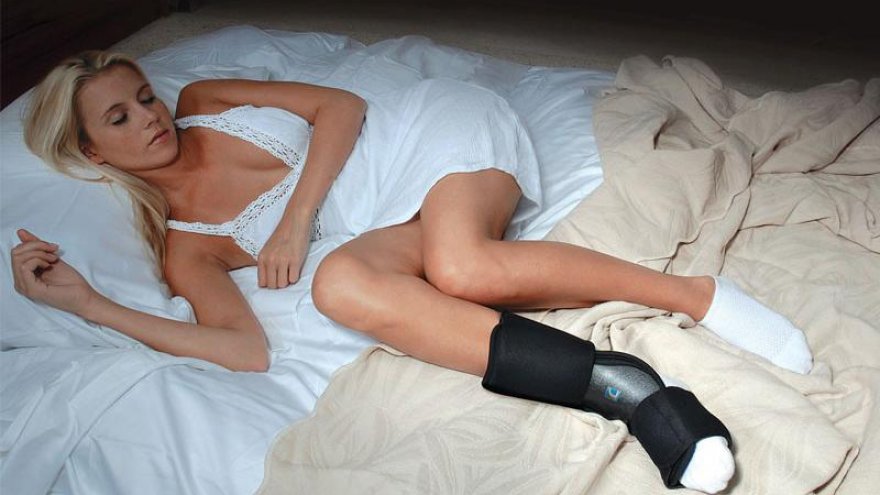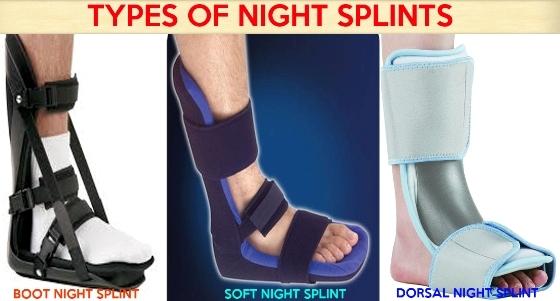How do night splints work for plantar fasciitis

Plantar fasciitis is a common issue for many runners out there. The mornings are especially dreadful moments, when you first put pressure on your feet. Good shoes with inserts are not always enough of a solution for this problem, so let’s take a look at another solution to help with this issue naturally?

Related: 10 Best Plantar Fasciitis Night Splints
Common symptoms are pain under the heel. The Pain is usually alleviated by walking or daily activity and after resting it seems to come back even worse. This is the reason why extreme pain comes in the morning when you do first steps. The new or advanced too much or too quickly activity or training are the main causes of Plantar fasciitis. Beside the limit these activity, using night splints is perhaps the best starting to consider. But, how do they work? Morning stretches can do so much for you in this case, but the all night stretch provided by a splint to many people is the most effective method they look for.
Most splints are not a particularly comfortable device to wear for reducing the pain from plantar fasciitis. For many people, wearing night splints when they are sleeping is really cumbersome. These products are essentially a brace which is attached to not only the foot, but the ankle and the lower leg as well, and is worn overnight. They have shown to provide obvious benefits in minimizing or completely resolving the worst step of the day.
At first, you should know the Benefits
- Help to stretch the plantar fascia ligament when you sleep which is intended to cut down stress on the inflamed area on the foot.
- Remarkably lessen initial pain when getting out of the bed in the morning
- Sustains stretch to the Calf muscles and Achilles tendon, which are thought to play a key role causing plantar fasciitis
There are two different types of night splints for plantar fasciitis, the dorsal and the boot. Their construction on opposite sides of the foot is the difference between two these types.
The Dorsal splint
The Dorsal splint keep the foot firmly in a 90-degree angle thanks to hard plastic support riding along the shin and top of the foot while still leaving the heel and arch free to breathe.
The Boot splint
The Boot splint is often a larger brace than the dorsal style including the spine of the brace on the back of the calf and leg and runs under the foot.
Related: 10 Best Plantar Fasciitis Night Splints
With each type of splints, there are some different complaints. For example, for The Dorsal splint does not hold the stretch because of design flaw or the larger straps cause sweating for your feet. For The Boot splint, it seems to be large and uncomfortable and it is difficult to walk in them when you have to get up. Therefore, up to your condition, you should consider to choose the best suitable splints for you. Besides, how to use and how long do you use them are also important notes on how to use the products effectively. The splints keeps your foot with the toes pointed up. This position is constant, lightly stretch to the plantar fascia. They also stretches the Achilles tendon at the back of the heel that prevents it from contracting. Dr. Langer advises that patients should wear splints until they notice an obvious improvement in there particular condition. The brace is often adjustable, so you can adjust it to the proper angle with your feet. Firstly, Adjust the fit so that the dorsiflexion straps offer a small amount of pressure against the bottom of your foot. Only you can feel your pain; and only you can know what is the correct tension of the night splint on your plantar fascia. You should keep in mind not to rush it, because you will only aggravate the condition. 6 to 8 weeks is the average minimum time for you to use the splints in conjunction with other treatments in order to solve the problem.
According to studies about the effects of using these kinds of products showed that using a tension night splint combined with ibuprofen, stretching and heel cushions offers good results in treating plantar fasciitis. Plus, another study showed that using these products combines with Arch Supports together may be more effective than using each individually in accelerating the healing process. A night splint is used to solve early morning pain by preventing contracture of Achilles tendon and the plantar fascia overnight. On the other hand, during prolonged weight bearing, an arch support solve pain at the end of the day by preventing overstretch of the plantar fascia. Generally, night splint is considered as good treatment option when is used in conjunction with other orthotic supports
In short, these devices are considered to be an effective treatment for plantar fasciitis, based on the real studies of patients. In addition to night splints, there are Other treatment options such as ice massaging of the inflamed area, exercises designed to stretch the plantar fascia ligament, physical therapy, anti-inflammatory medication, and shoe inserts/orthotics for Plantar Fasciitis as well.
Latest Articles
 Is Running on a Treadmill Easier Than Running Outside?Runners have their own preferences, whether it is treadmill running, running outside on the road, or exploring trails. So...
Is Running on a Treadmill Easier Than Running Outside?Runners have their own preferences, whether it is treadmill running, running outside on the road, or exploring trails. So... Is It OK to Use Trail Running Shoes on the Road?While trail running shoes can be used on roads, especially in situations where a runner encounters mixed terrains or pref...
Is It OK to Use Trail Running Shoes on the Road?While trail running shoes can be used on roads, especially in situations where a runner encounters mixed terrains or pref... How to Fix Sore Quads After Running?Rest, ice, gentle stretching, and over-the-counter pain relievers can help soothe sore quads after running. Also, ensure ...
How to Fix Sore Quads After Running?Rest, ice, gentle stretching, and over-the-counter pain relievers can help soothe sore quads after running. Also, ensure ... 10 Fruits With The Most Electrolytes to Replace Sports DrinksThese fruits are high in electrolytes such as potassium, magnesium, and calcium, essential for hydration, muscle function...
10 Fruits With The Most Electrolytes to Replace Sports DrinksThese fruits are high in electrolytes such as potassium, magnesium, and calcium, essential for hydration, muscle function...

